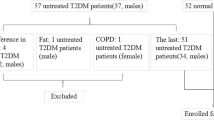Summary
The elastic and functional coupling of heart and vessels makes the stroke work (SW) of the heart optimal. Speckle tracking imaging (STI) can evaluate the myocardial strain and function. We studied ventricular-vascular coupling in 80 diabetic patients with different systolic function using STI. The patients were divided into two groups according to ejection fraction (EF): the diabetes mellitus with normal EF (DMN) group and the diabetes mellitus with abnormal EF (DMA) group. Forty-two volunteers served as control group. The relative wall thickness (RWT), left ventricular mass index (LVMI), stroke volume (SV), SW, rate-pressure product (RPP), systemic vascular resistance index (SVRI), left ventricular end-systolic elastance (Ees), effective arterial elasticity (Ea) and ventricular-vascular coupling index (VVI) were measured and calculated by conventional echocardiography. The longitudinal strain (LS) at basement (LSBA), papillary muscle (LSPM) and cardiac apex (LSAP) was assessed with STI. It was found: (A) compared with control group, in DMN and DMA groups, LSBA, LSPM and LSAP decreased, and they were lower in DMA group. (B) VVI, RPP and SVRI increased, and they were higher in DMN group; Ees decreased, and it was lower in DMA group. (C) LSBA, LSPM, and LSAP had negative correlation with VVI. LSAP, RWT, LVMI and SW were independent predictors for VVI. The area under the receiver operating characteristic (ROC) curves was used for identification of DMA and DMN with LSBA, LSPM, and LSAP, and the area under the ROC of LSAP was the largest. This study supports that myocardial LS could reflect the ventricular-vascular coupling. Different segments had an order to “respond to” the state of the coupling, and the cardiac apex might be the earliest.
Similar content being viewed by others
References
Nicklett EJ, Heisler ME, Spencer MS, et al. Direct social support and long-term health among middle-aged and older adults with type 2 diabetes mellitus. J Gerontol B Psychol Sci Soc Sci, 2013,68(6):933–943
Scott LK. Presence of type 2 diabetes risk factors in children. Pediatr Nurs, 2013,39(4):190–196
Simić I, Pećin I, Tedeschi-Reiner E, et al. Risk factors for microvascular atherosclerotic changes in patients with type 2 diabetes mellitus. Coll Antropol, 2013,37(3): 783–787
Tao L, Wilson EC, Griffin SJ. Performance of the UKPDS outcomes model for prediction of myocardial infarction and stroke in the ADDITION-Europe trial cohort. Value Health, 2013,16(6):1074–1080
Komajda M, McMurray J, Bigelow R, et al. Results of a reevaluation of cardiovascular outcomes in the RECORD trial. Am Heart J, 2013,166(2):240–249
Asanoi H, Sasayama S, Kameyama T. Ventriculoarterial coupling in normal and failing heart in humans. Circ Res, 1989,65(2):483–493
Prabhu SD. Altered left ventricular-arterial coupling precedes pump dysfunction in early heart failure. Heart Vessels, 2007,22(3):170–177
Ryczek R, Krzesiński P, Krzywicki P, et al. Two-dimensional longitudinal strain for the assessment of the left ventricular systolic function as compared with conventional echocardiographic methods in patients with acute coronary syndromes. Kardiol Pol, 2011,69(4): 357–362
Gorcsan J 3rd, Tanaka H. Echocardiographic assessment of myocardial strain. J Am Coll Cardiol, 2011,58(14): 1401–1413
Turto H, Lommi J, Ventilä M, et al. Doppler echocardiography markedly underestimates left ventricular stroke work loss in severe aortic valve stenosis. Eur J Echocardiogr, 2007,8(5):341–345
Moro PJ, Flavian A, Jacquier A, et al. Gender differences in response to cold pressor test assessed with velocity-encoded cardiovascular magnetic resonance of the coronary sinus. J Cardiovasc Magn Reson, 2011,13:54–63
Kelly RP, Ting CT, Yang TM, et al. Effective arterial elastanceas index of arterial vascular load in humans. Circulation, 1992,86(2):513–521
Sunagawa K, Maughan WL, Burkhoff D, et al. Left ventricular interaction with arterial load studied in isolated canine ventricle. Am J Physiol, 1983,245(5 Pt 1):H773–H780
Schroth M, Plank C, Meissner U, et al. Hypertonic-hyperoncotic solutions improve cardiac function in children after open-heart surgery. Pediatrics, 2006,118(1): e76–84
Takeuchi M, Nishikage T, Nakai H, et al. The assessment of left ventricular twist in anterior wall myocardial infarction using two-dimensional speckle tracking imaging. J Am Soc Echocardiogr, 2007,20(1):36–44
Luo X, Cao T, Li Z, et al. A preliminary study on the evaluation of relationship between left ventricular torsion and cardiac cycle phase by two-dimensional ultrasound speckle tracking imaging. Int J Cardiovasc Imaging, 2009,25(6):559–568
Sunagawa K, Sagawa K, Maughan WL. Ventricular interaction with the loading system. Ann Biomed Eng, 1984,12(2):163–189
Sunagawa K, Maughan WL, Sagawa K. Optimal arterial resistance for the maximal stroke work studied in isolated canine left ventricle. Circ Res, 1985,56(4):586–595
Sasayama S, Asanoi H. Coupling between the heart and arterial system in heart failure. Am J Med, 1991,90(5B): 14S–18S
MacGowan GA, Shapiro EP, Azhari H, et al. Noninvasive measurement of shortening in the fiber and cross-fiber directions in the normal human left ventricle and in idiopathic dilated cardiomyopathy. Circulation. 1997,96(2):535–541
Kass DA. Ventricular arterial stiffening: integrating the pathophysiology. Hypertension, 2005,46(1):185–193
Author information
Authors and Affiliations
Corresponding author
Additional information
This project was supported by a grant from the Shanghai Health and Family Planning Commission, China (No. 201440290).
Rights and permissions
About this article
Cite this article
Li, Zj., Du, Lf. & Luo, Xh. Evaluation of ventricular-vascular coupling in patients with type 2 diabetes mellitus using 2-dimensional speckle tracking imaging. J. Huazhong Univ. Sci. Technol. [Med. Sci.] 34, 929–934 (2014). https://doi.org/10.1007/s11596-014-1376-z
Received:
Revised:
Published:
Issue Date:
DOI: https://doi.org/10.1007/s11596-014-1376-z




